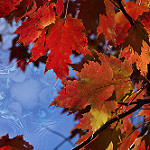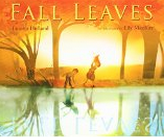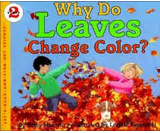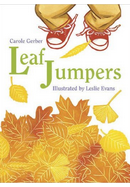Reading Through the Seasons: October’s Falling Leaves
Author: Kelly Matteri
Published: 09.22.16

(This blog post was originally published in October, 2015)
“October was a beautiful month … Anne reveled in the world of color about her.
“Oh...,” she exclaimed..., “I’m so glad I live in a world where there are Octobers. It would be terrible if we just skipped from September to November, wouldn’t it? Look at these maple branches. Don’t they give you a thrill—several thrills?”
-From of Anne of Green Gables, by Lucy Maud Montgomery
Like Anne of Green Gables, I am a lover of autumn leaves, glad to be living in a world where there are Octobers. I have my mother to thank for my love of autumn’s crunchy, colorful display. As far back as I can remember, she has greeted the turning of leaves with whole-hearted exclamations of joy and wonder. With an artist’s eye, she reverently points out the many lovely colors and shapes of their falling leaves. She wonders aloud about the science behind nature’s annual magic trick. She always seems to have the perfect word to describe a leaf’s color, texture, or movement.
Being a teacher and a mother has given me the opportunity to happily carry on the tradition of observing, exploring, and describing fall leaves with the young children in my life. Our explorations begin outdoors. Children need opportunities to investigate autumn leaves first hand. There is no substitute for watching actual trees drop their leaves, for touching the leaves, examining their forms, feeling their textures, and noticing the varying shades and intensities of their colors. Autumn is nothing if not a sensory experience.
A well-chosen book can deepen this initial sensory-based exploration. Written text and graphics explain ideas that are abstract, or cannot be easily detected by our senses. The internal structure of a leaf, for example, is more readily understood via text and graphics in a book than by observing with the naked eye.
The academic language often used in books is also beneficial. As children develop more extensive content knowledge, they begin to think more deeply about their observations and ask more probing questions. Communicating complex thoughts and questions requires a stronger command of academic language. Books often model the use of such language for students.
Written to inspire a new generation of leaf peepers, the following books will give children “several thrills” as they explore the art, science, and poetry of autumn leaves. I’ve noted a just a few of the many possible connections each book has to various content areas.
See you amongst the trees, fellow readers! I’ll be the one with leaves in my hair and a book in my hand.
 Fall Leaves,written by Loretta Holland and illustrated by Elly MacKay
Fall Leaves,written by Loretta Holland and illustrated by Elly MacKay
Science:
- Varied shapes and colors of leaves
- Interior structure of leaves (Contains an informative diagram, with an age-appropriate level of detail)
- Decomposition
- Effect of variables on leaf color (Ex: chlorophyll, pigment, temperature, precipitation)
English - Language Arts:
- Compare and contrast
- Multiple meaning words (The text repeatedly highlights two word subject/verb phrases. These phrases provide an excellent opportunity for a study of the various meanings of the words ‘fall’ and leave’.)
 Why Do Leaves Change Color? written by Betsy Maestro and illustrated by Loretta Krupinski
Why Do Leaves Change Color? written by Betsy Maestro and illustrated by Loretta Krupinski
Science:
- Changing seasons, hemispheres
- Hibernation, perennials
- Deciduous trees, chlorophyll
Social Science
- Where produce (apples) come from
English-Language Arts:
- Text structures (Cause and effect, compare and contrast)
 Leaf Jumpers, written by Betsy Maestro and illustrated by Loretta Krupinski
Leaf Jumpers, written by Betsy Maestro and illustrated by Loretta Krupinski
English - Language Arts:
- Descriptive language
- Rhyming words
- Use illustrations to determine meaning of unknown words
Math
- Analysis, comparison, and sorting/categorization
Science
- Seasonal change
- Deciduous trees
- Basic concept of photosynthesis
Blog: English Language Arts

